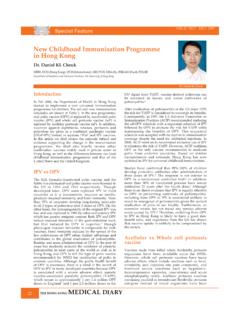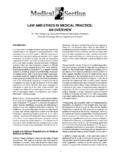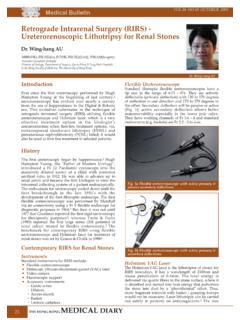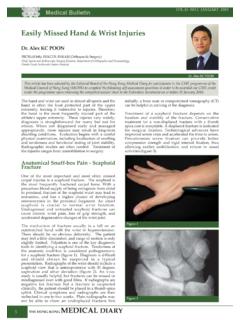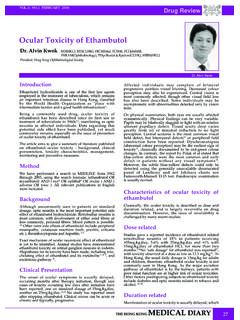Transcription of Health Care Benchmarking - fmshk.org
1 FEBRUARY 2007 What is Benchmarking ? Benchmarking is a process of comparison between theperformance characteristics of separate, oftencompeting organisations intended to enable eachparticipant to improve its own performance in themarketplace. Its objectives are to obtain a clearerunderstanding of competitors and of customers'requirements. Benchmarking will also enableinnovations (either of process or product) to spreadmore rapidly through an industry and across industrieswhere appropriate (Beckford, 1998).The Benchmarking theory is built upon performancecomparison, gap identification and changes in themanagement process (Watson, 1993; Camp, 1989; Karlofand Ostblom, 1993).
2 By reviewing the benchmarkingliterature (Camp, 1989; Zairi, 1992; Smith et al., 1993;Rogers et al., 1995), it seems obvious that Benchmarking :Despite these benefits, time constraints, competitivebarriers, cost, lack of both management commitment andprofessional human resources, resistance to change, poorplanning and short term expectations are regarded as themain problems affecting successful benchmarkingresearch (Bendell et al., 1993). A poorly executedbenchmarking exercise will result in a waste of financialand human resources, as well as time.
3 IneffectivelyHelps organisations to understand where they havestrengths and weaknesses depending upon changesin supply, demand and market conditionsAllows organisations to realise what level(s) ofperformance is really possible by looking at others,and how much improvement can be achievedHelps organizations to improve their competitiveadvantage by stimulating continuous improvementin order to maintain world class performance andincrease competitive standardsHelps to better satisfy the customers' needs forquality, cost, product and service by establishingnew standards and goalsPromotes changes and delivers improvements inquality, productivity and efficiency.
4 Which in turnbring innovation and competitive advantageIs a cost effective and time efficient way ofestablishing a pool of innovative ideas from whichthe most applicable practical examples can beutilisedTo be keen on new developments within therelated area, and improves the motivation Benchmarking projects may have tarnished anorganisation's image (Elmuti and Kathawala, 1997).Moreover, there is no single 'best practice' because itvaries from one person to another and everyorganisation differs in terms of mission, culture,environment and technological tools available.
5 Thus,there are risks involved in Benchmarking others and inadopting new standards into one's own 'best practice' should be perceived or accepted to beamong those practices producing superior outcomesand being judged as good examples within the , Benchmarking findings may remove theheterogeneity of an industry since standards willthemselves become globally standardised and attemptsto produce differentiation may fail (Cox and Thompson,1998).Overall, Benchmarking first requires seniormanagement commitment, particularly to supportingactions arising from the exploration.
6 Second, it requiresstaff to be trained and guided in the process to ensurethat maximum benefit is obtained. Finally, it requiresallocation of part of the relevant employees time toenable it to be carried out (Beckford, 1998).DefinitionsBenchmarking has been given many differentdefinitions by different organisations and authors eventhough each aims to reach the same conclusion (seeTable 1). It has been defined by Camp (1989) simply as"the search for industry best practice that leads tosuperior performance". In other words, benchmarkingis a process of finding what best practices are and thenproposing what performance should be in the three principles of Benchmarking are maintainingquality, customer satisfaction and continuousimprovement (Watson, 1993).
7 Benchmarking studies are perishable and time is a standard of excellence today may be theexpected performance of tomorrow. Improvement is acontinuous process, and Benchmarking should beconsidered as a part of that process. As a result,although different authors have defined benchmarkingin different ways, all these definitions have a commontheme, namely: the continuous measurement andimprovement of an organisation's performance againstthe best in the industry to obtain information about newworking methods or practices in other organisations(Kozak, 2004).
8 Health care BenchmarkingDr. Jay FL KayMBBS(Qid), MRCP(UK), FHKCP, FHKAM(Medicine)Specialist in MAY FEBRUARY 2007 Benchmarking ProcessAs implied in the various definitions offered, Benchmarking is a continuous process. It encouragesthe use of Plan-Do-Study-Act (PDSA) cycles whenaction planning and implementing improvements. Theplan phase focuses on the various up front decisionssuch as the selection of functions/processes tobenchmark and the type of Benchmarking study onwhich to embark. In do, one delves in a self study tocharacterise the selected processes using metrics anddocumenting business practices.
9 Furthermore, data(metrics and business practices) are collected on thecompany that is the Benchmarking partner. Study refersto the comparison of findings via a gap analysis toobserve whether negative or positive gaps existbetween the Benchmarking company and thebenchmarking partner. Act refers to the launching ofprojects either to close negative gaps or maintainpositive gaps. This is the stage that distinguishesbenchmarking from "organised industrial tourism"(Pulsat 1994). The PDSA cycle is a recognised"framework for efficient trial-and-learningmethodology" which emphasises action-based learningto generate knowledge and predict whether change willresult in improvement (Langley et al 1996).
10 Types of benchmarkingThe Benchmarking literature can be mainly separatedinto two parts: internal and external , functional and generic benchmarkings areclassified under external Benchmarking (Camp, 1989;Zairi, 1992). The process is essentially the same for eachcategory. The main differences are what is to bebenchmarked and with whom it will be benchmarkingInternal Benchmarking covers two waycommunication and sharing opinions betweendepartments within the same organisation or betweenorganisations operating as part of a chain in differentcountries (Cross and Leonard, 1994; Breiter and Kline,1995).
